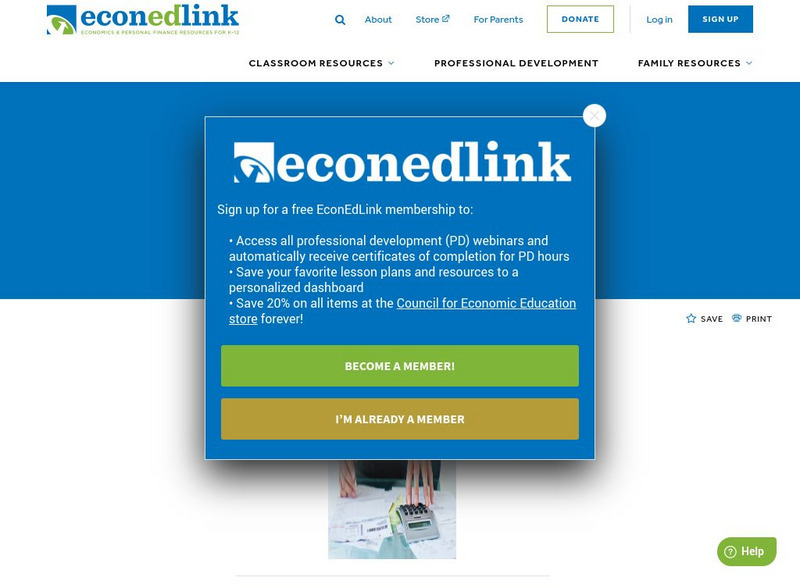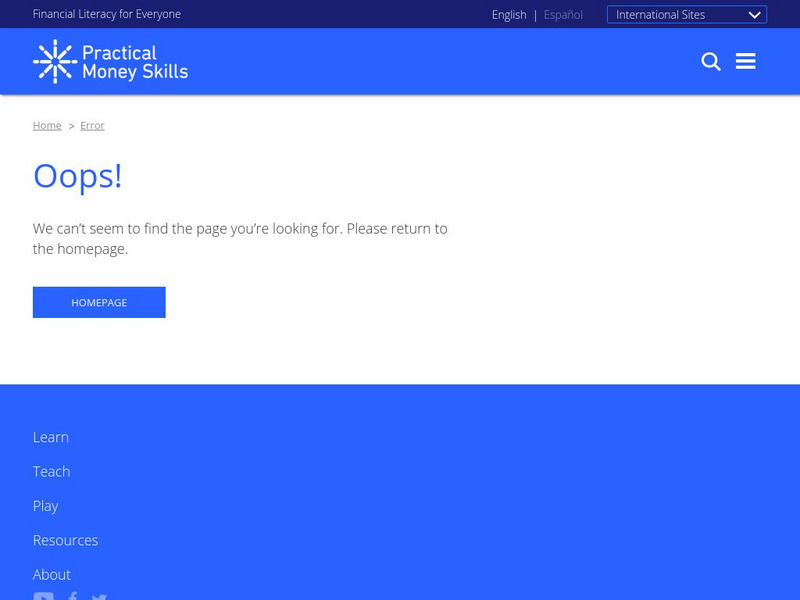Practical Money Skills
Practical Money Skills: Lesson One: Making Spending Decisions
The goal of this lesson is to introduce structured spending decisions to assist young children in making choices and to recognize that money comes in limited amounts.
Practical Money Skills
Practical Money Skills: Lesson Two: Spending Plans
This instructional activity introduces children to the concept of dividing their money into categories, namely "save," "spend," and "share" and presents activities that will help them understand that money is limited in quantity and must...
Smithsonian Institution
Smithsonian Learning Lab: What Shape Is Money? Money Doesn't Have to Be Round or Rectangular
Pigs, rice, nuts, teeth, eggs, feathers - these are all types of currency! This lesson discusses different types of objects that can be used as currency and students will decide what qualities make an effective currency. Included are...
Khan Academy
Khan Academy: Lesson Summary: Definition, Measurement, and Functions of Money
This information is intended for AP Macroeconomics students or for those taking college macroeconomics. This lesson reviews key terms and calculations related to the definition, measurement, and functions of money. Topics include the...
Council for Economic Education
Econ Ed Link: Do I Look Like I'm Made of Money?
One of the most common replies given by parents when their children ask for money is "Do I look like I'm made of Money?" This lesson is designed to educate learners about the need for money as a generally accepted medium of exchange. The...
Council for Economic Education
Econ Ed Link: The Need for Money That Everybody Can Use
The U.S. Currency currently has two faces. The old bills are being replaced with new designs. The study of the look of the bills will lead into a discussion of their usefulness for a segment of our population: the visually impaired people.
Practical Money Skills
Practical Money Skills: Lessons: Pre K Grade2
Four lessons on basic money skills for young learners cover topics such as identifying money, spending money, and earning money.
Scholastic
Scholastic: Adventures in Math: Lesson 3: Money in Our Community
Lesson focuses on how and why money circulated within our community. Being able to discern the difference between things we need and things we want is one of the foundational concepts for using money wisely. Goods and services are things...
Consumer Financial Protection Bureau
Consumer Financial Protection Bureau: Bouncing Ball Money Choices
Students play a game to share how they think and feel about money.
Council for Economic Education
Econ Ed Link: Money Comes and Goes
Students read two online stories that introduce them to the elements of a budget and show that a successful budget balances money coming in (income) with money going out (expenses and savings). Follow-up activities point out the value of...
Better Lesson
Better Lesson: Hundreds, Tens, Ones Are Coins Too
Second graders will extend their understanding of hundreds, tens and ones using dollars, dimes and pennies as another way to express groups of 100, 10 and 1.
Scholastic
Scholastic: Adventures in Math: Lesson 1: Saving Money for Your Future
Tips for learning the value of saving money to achieve your financial goals.
Smithsonian Institution
Smithsonian Education: What's It Worth? Thinking About Weights and Measures
A activity on the system of currency used by the Akan people of Ghana and how it compares to systems used today.
Federal Reserve Bank
Federal Reserve Bank of Philadelphia: Why Money? [Pdf]
Students learn about barter, and the benefits of using money, as they participate in this trading simulation.
CPALMS
Cpalms: Dollars for Density
This is a guided inquiry activity in which students use simple lab procedures and discussions to develop and apply the concept of density. Students collect and graph data which they use to explore the relationship between mass and...
University of Texas
Inside Mathematics: Pocket Money [Pdf]
This task challenges a student to demonstrate fluency in adding and subtracting whole numbers.
Scholastic
Scholastic: Adventures in Math: Lesson 1: Money Matters
The process of earning money is the cornerstone of financial literacy. For this lesson, young scholars will identify key terms associated with earning money, explore ideas for earning money now, and evaluate various career options as...
Council for Economic Education
Econ Ed Link: Multipliers and the Mystery of the Magic Money
Students learn about the purpose of the reserve requirement, how money is "created" in the economy through fractional reserves, and how the Federal Reserve uses the reserve requirement and loans to correct economic instability.
Writing Fix
Writing Fix: Smart Math and Writing
In this lesson, the poem "Smart" from Where the Sidewalk Ends, by Shel Silverstein, is used as the mentor text. Students will write a map of the poem and then analyze it to discover what happened when trades with money were made and...
Federal Reserve Bank
Federal Reserve Bank of Atlanta: Building Block Barter Lesson
Lesson plan for 3 - 5 graders about the advantages of using money instead of bartering.
Illustrative Mathematics
Illustrative Mathematics: 6.rp Currency Exchange
Students use ratio and rate to answer this performance task: Joe was planning a business trip to Canada, so he went to the bank to exchange $200 U.S. dollars for Canadian dollars (at a rate of $1.02 CDN per $1 US). On the way home from...
Practical Money Skills
Practical Money Skills at Home: Allowance and Savings
Ideas to teach children the importance of saving and the value of an allowance using this activity. Suggestions for conveying these ideas include related worksheets to help children better grasp these concepts.
Council for Economic Education
Econ Ed Link: Jesse 'The Body' Wants to Give Money Away!
During his campaign for governor of the State of Minnesota, former professional wrestler Jesse "The Body" Ventura, promised to return to the taxpayers of Minnesota the budget surpluses that had been accumulating in the state. Upon...
Illustrative Mathematics
Illustrative Mathematics: 2.nbt Saving Money 1
In this lesson plan students use strategies based on place value to add and subtract within 100.
Other popular searches
- Money Lessons
- Counting Money
- Adding and Subtracting Money
- Adding Money
- Money Math
- Money and Currency
- Money Games
- Australian Money
- Money Lesson Plans
- Money Place Values
- Saving Money
- Counting Money Worksheets








![Federal Reserve Bank of Philadelphia: Why Money? [Pdf] Lesson Plan Federal Reserve Bank of Philadelphia: Why Money? [Pdf] Lesson Plan](http://content.lessonplanet.com/resources/thumbnails/409976/large/bwluav9tywdpy2symdiwmduymc0xmdm5ny0xdnbua3j3lmpwzw.jpg?1589982798)



